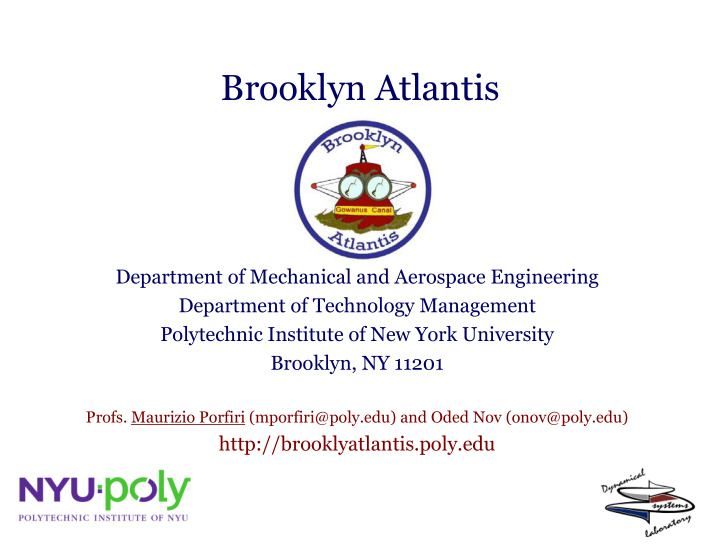



Brooklyn Atlantis Department of Mechanical and Aerospace Engineering Department of Technology Management Polytechnic Institute of New York University Brooklyn, NY 11201 Profs. Maurizio Porfiri (mporfiri@poly.edu) and Oded Nov (onov@poly.edu) http://brooklyatlantis.poly.edu 1/16
NYU-Poly NYU-Poly Gowanus 2/16
Team The Brooklyn Atlantis team Lead by Profs. Nov and Porfiri, The Brooklyn Atlantis team consists of 8 graduate students in Mechanical Engineering and Computer Science, as well as 6 undergraduate researchers. Team members, left to right: Nitin Narasimhan, Aditya Guntupalli, Jeffrey Laut, Fausto Del Sette, Prof. Oded Nov, Prof. Maurizio Porfiri, Emiliano Henry, Vladislav Kopman, and Andrea Clerico. Not pictured: Sohan Gharpure, William Quigley, Kamran Khan, Jakub Cichon, Nagpal Kshitij, Matthew Conte, 3/16 and Vivin Raj
Overview What is Brooklyn Atlantis? • Brooklyn Atlantis is a National Science Foundation (NSF) funded project • It consists of socially interacting volunteers and a wireless sensor network jointly performing tasks • Citizen scientists help with environmental monitoring and control in the polluted waters of the Gowanus Canal • A system of mobile instrumented buoys with wireless capabilities analyze the waters, take pictures, and gather data using a variety of sensors 4/16
Efforts Our project is focused on the Gowanus Canal. So what is our effort? • Help monitor the water quality by supplying data to the EPA • Provide images of above water and below water animal presence • Provide an online platform (website) for citizen scientist social participation • Investigate human-machine interaction, and its effects on the performance of a sensor network 5/16
Citizen Science What is Citizen Science? Research conducted, in whole or in part, by amateur or non-professional scientists as part of a scientific research effort Who are the Gowanus Citizen Scientists and how can they help? Potentially YOU! By participating on the Brooklyn Atlantis website, volunteers can help researchers monitor the wildlife and the conditions in the canal and collaboratively make the Gowanus environmental recovery a reality 6/16
Gowanus Wildlife The Gowanus Canal is populated with fish, birds and small mammals The EPA has observed the aquatic life to include: • Annelid worms • Mummichogs • Sand worms • Atlantic tomcods • Amphipods • American eels • Small mollusks • Striped bass • Blue crabs • White perch • Copepods • Muskrats The avian life typically encountered includes: • Black ducks • Blue herons • Crested cormorants 7/16
Self-Contained Mobile Buoy How are we going to monitor the waters? With a self-contained mobile buoy, a device with the following abilities: • Move about the canal • Test water quality • Take pictures above and below water • Upload data to our website • Maintain position using an anchor • Recharge its batteries using solar energy 8/16
BrooklynAtlantis.poly.edu How do Citizen Scientists participate? By logging on to our website, participants can: • Browse images of canal snapshots • Classify wildlife discovered in pictures • Access sensor data for different canal locations for assessing water quality • Gain points by correctly identifying objects • Compare tagging results with a network of friends 9/16
Image analysis (1) Images are captured from above water and below water cameras: these images get uploaded about once every minute, where they can then be accessed on the project’s website Users can then tag the photos: • Participants scroll through different snapshots sent from the buoy cameras • Once an object is identified, it is tagged with a name and a description 10/16
Image Analysis (2) How does tagging work? 11/16
Data Acquisition The sensor data is collected by the onboard computer and uploaded to the project website where it is displayed graphically • The dissolved oxygen sensor gives a measure of the oxygen content in the canal. • The pH sensor measures the acidity and alkalinity of the water. • The conductivity sensor tests the concentration of certain pollutants. These sensors are used to assess the canal’s ability to sustain life, and monitor the progress of the environmental cleanup 12/16
Mobility of the Robot How can the robot monitor different areas of the canal? • Two thrusters allow the buoy to maneuver about the canal, while GPS provides location data • The motorized anchor allows the robot to remain stationary for extended periods without the use of thrusters • Either of the cameras can also stream video for controlling the robot from a remote location 13/16
Preliminary Testing The prototype has been tested in several controlled environments, and more recently, in the Gowanus Canal, where it successfully maneuvered and uploaded image data to our server remotely More short-term deployment trials will be performed before the robot’s permanent deployment. We then plan on developing more to make a network of five robots in total throughout the canal 14/16
Project Impact Beyond the scientific insight this project will produce, we also expect Brooklyn Atlantis to • Inspire non-scientists to become involved and interested in science • Raise awareness of the clean-up effort at the Gowanus Canal and the status of the canal • Promote research and education in Brooklyn • Be used as an educational tool in outreach programs 15/16
Thank you! Questions? 16/16
Recommend
More recommend